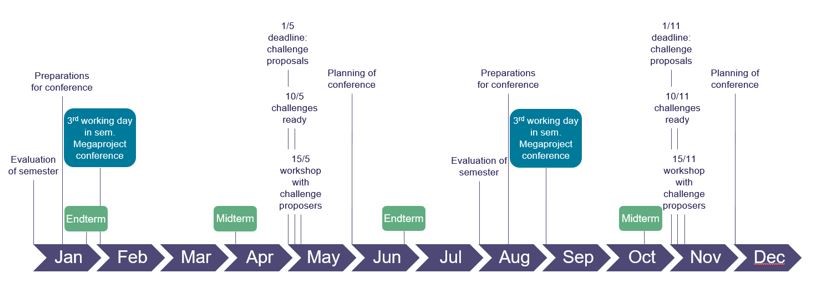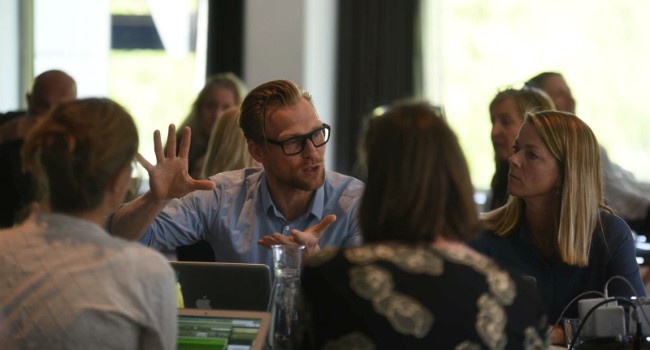In order to launch a megaproject, certain conditions need to be in place. Megaprojects at AAU are a concept with a fixed framework that must be met before launching the individual megaproject. The framework is there to ensure solid anchoring of the individual megaprojects, interdisciplinarity and the inclusion of the 17 Sustainable Development Goals.
The overall structure of the megaproject consists of three levels.

MEGAPROJECTS
At the top level is the megaproject. This level consists of the title of the megaproject and overall description. The megaproject serves as an overarching umbrella, and the work on megaproject work must address this title.
A megaproject must:
- In its title and overall description, be broad enough to be relevant for a minimum of four different faculties
- Be anchored in a specific department (host department) that appoints a coordinator for the project
- Have up to three clearly defined focus areas
FOCUS AREAS
The focus areas are a breakdown of topics in the individual megaproject. The focus areas will serve as benchmarks for the challenges that are subsequently made.
- A megaproject has a maximum of three focus areas
- The focus areas must be relevant for a minimum of three faculties; these must be both the natural/physical areas (TECH, ENGINEERING and MEDICINE) as well as the behavioral/interpretative areas (Humanities and Social Sciences)
- Each focus area must be related to the 17 Sustainable Development Goals The Sustainable Development Solution Network’s SDG impact assessment tool can be used here
- Each focus area must be sufficiently broad to be able to contain diverse challenges
CHALLENGE
The challenges are the basis for the students’ semester projects The challenges are a specification of the focus areas and must address a specific area or issue that can be dealt with in several different projects
- There can be a maximum of two challenges in a focus area
- The challenges must be relevant to, and qualify in, at least one faculty other than that of the challenge contributors
- Challenges are made by researchers at AAU, but may also be made by external partners
- The challenge must be related to the 17 Sustainable Development Goals The Sustainable Development Solution Network’s SDG impact assessment tool is used here
- Challenges must have an "owner" who takes part in the megaproject conference and can answer questions Researchers who contribute to qualifying the challenge become co-contributors of the challenge
- Proposals for challenges must be submitted no later than 1 May/November
- The framework for each challenge is very broad, only limited by your imagination
Learn more about making challenges
It takes time to get a megaproject off the ground so up to a year is needed for developing and defining the megaproject, the organizational anchoring, business partners and scheduling with regard to deadlines.
If you are interested in starting a megaproject, contact Katrine Eckhardt Bjerg, project manager for the megaprojects
EXTERNAL PARTNERS
The aim of the megaprojects is to build bridges between students, the real world and the Sustainable Development Goals. This demands that the megaprojects include external partners. So a megaproject must also have a cooperation agreement. In conjunction with the project manager for the megaprojects, the host department determines how to integrate the external partner(s) into the megaproject.
Accommodating external partners in the megaproject depends on how the individual megaproject is constructed. However, the construction of any megaproject must be based on the wishes of one or more partners. Whether this is through the overall issue being addressed in the megaproject, or with the focus areas having their own external collaborative parties, depends on what best suits the megaproject.
The cooperation agreement obligates each partner to:
- Relate to the UN Sustainable Development Goals with regard to the megaproject
- Participate in relevant meetings
- Make information and relevant documents available to students
- Be available to students during the semester, to an extent agreed on
Additionally, external partners are always welcome to participate in mid-term and end-term seminars.
TIMELINE
When a megaproject is running, a few tasks need to be done. These tasks mainly concern challenges being made, adapted or changed; preparation for the megaproject conference at the beginning of each semester; and a smaller evaluation of the semester at its end. In addition, the tasks consist primarily of cooperation meetings with external parties, working group meetings, ad hoc tasks, and assisting the students.

PROJECT TIMELINE
As the different faculties do not follow the same time frame for projects, it is important to be aware of adapting individual semester projects to the structure of the megaprojects.
The deadlines students must meet are placed so that the different curriculums and time frames can be adapted. This means that the submission times may be inappropriately either early or late in the project work, but this is done in order to be able to embrace the widest range of scenarios possible.
The structure of the megaprojects puts particular demands on students in programmes where project work is started after the first month of the semester. In these cases, students need to independently form groups and prepare project proposals to be part of the megaprojects. Programmes or departments may provide individual solutions for this, but normally it is the responsibility of the students to comply with deadlines.
Similarly, students who start project work from the first day of the semester may find that deadlines are late in the process. This is a necessity as this is the prerequisite for the interdisciplinary collaboration in the megaprojects. Students are largely autonomous when it comes to their agreements and can therefore adjust the dates in the individual challenge network themselves.


